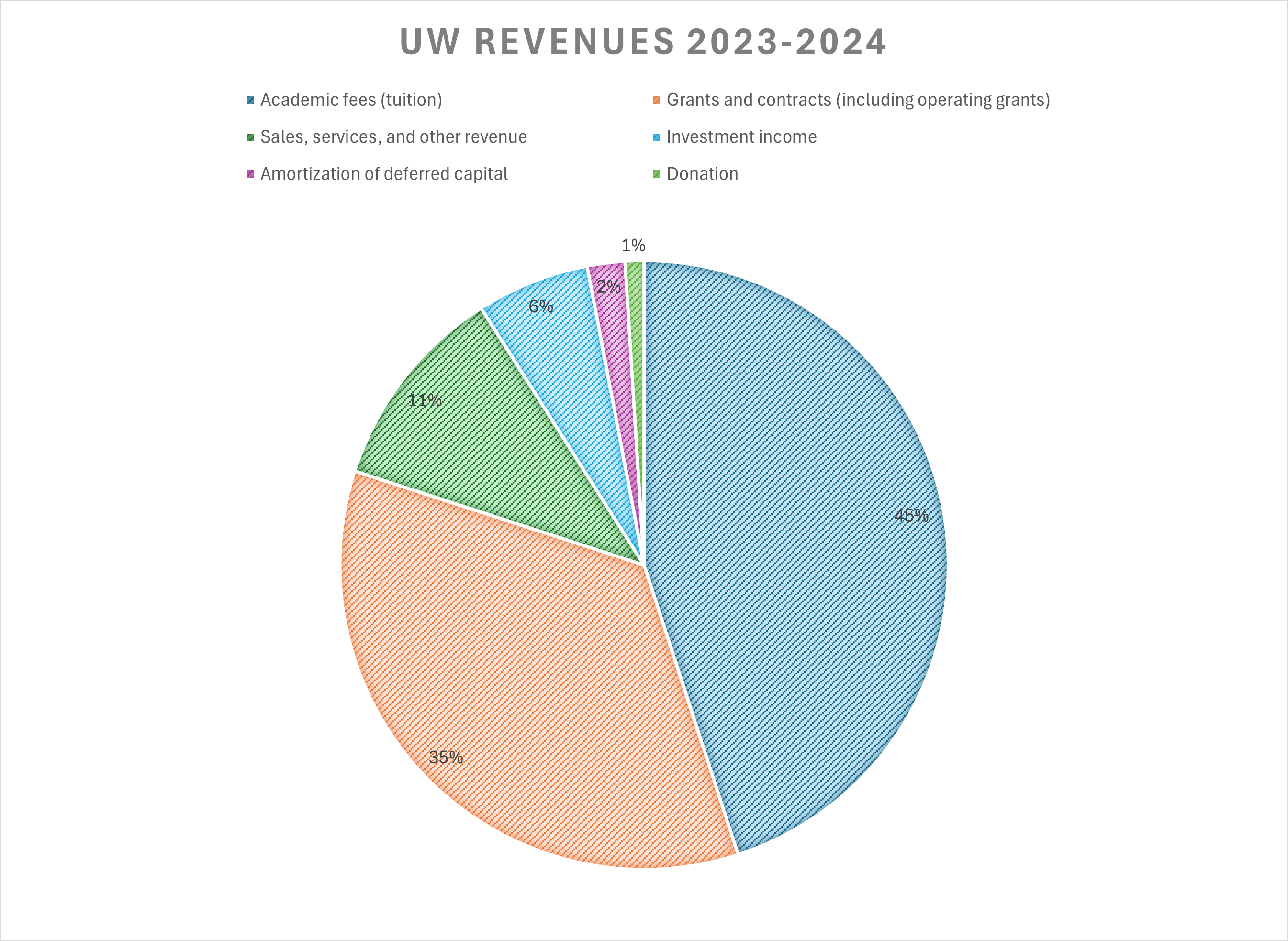UW’s financial deficit: where the university stands in 2025
| February 14, 2025

A pie chart titled “UW Revenues 2023-2024” shows revenue sources: 46% academic fees, 36% grants and contracts, 11% sales/services/other, 6% investment income, 1% amortization, and <1% donations—key details for understanding the UW budget.
A pie chart titled "UW Revenues 2023-2024" shows revenue sources: 46% academic fees, 36% grants and contracts, 11% sales/services/other, 6% investment income, 1% amortization, and <1% donations—key details for understanding the UW budget.
In UW president Vivek Goel’s message at the end of last year, it was announced that unit-level spending was permanently reduced by $42 million. The remaining $33 million of the $75 million deficit will be covered by funds which had initially been set aside for longer-term initiatives, and therefore future deficits pose a significant threat to the university’s financial sustainability. This means that maintenance projects — such as replacing heating/cooling systems and repairing leaking roofs — will not be able to move forward. Additionally, the university has stated that limited funding will force a number of planned IT projects to be delayed (one of these projects would replace UW’s student information system before the underlying technology is decommissioned).
UW’s funding comes from several sources, with the two biggest ones being tuition and grants from the government. Combined they make up 80 per cent of the 2023-2024 budget (the latest budget publicly available); tuition makes up 45 per cent of the budget and grants make up 35 per cent of the budget. Tuition for domestic students has been frozen since 2019 and this freeze is to continue until 2027. The total increase in tuition revenue at UW from 2020 to 2024 was 14 per cent with 12 per cent of that coming in 2021. Operating grants have also seen minimal increases, also coming in at 14 per cent with the majority of that coming in 2024. Inflation over that same time period increased by 16.5 per cent. The Ontario government provided a one-time $1.2 billion financial aid package to help colleges and universities to “stabilize” their finances, accounting for the large increase that year. This came shortly after a government commissioned blue-ribbon panel was released.
Noting that several Ontario universities faced financial difficulties, Ontario’s blue-ribbon panel released a report outlining recommendations for ensuring financial stability within the postsecondary sector. These recommendations included a one-time 10 per cent increase in per-student funding as well as a 5 per cent tuition increase. The report also noted that government operating grants for universities had gone down by $164 in nominal value between 2008 and 2021. It also noted that per-student funding in Ontario was 57 per cent compared to the rest of Canada.
After last year’s announcement that they will face a $75 million deficit for the 2024-25 operating budget, UW has continued to share information about their current financial situation. With the 2025-2026 fiscal year beginning this coming May, leaders at the university are continuing to look at a range of strategies to reduce spending.
The latest update on these strategies came on Jan. 27, as UW once again made an announcement to community members about their financial situation. Included in this announcement was the link to a new website dedicated to providing budget information and answers to frequently asked questions. According to UW, the “Waterloo Budget Plan” website will aim to share “background on our financial situation, details on the measures we are taking and resources [the community] can refer to.”
With the implementation of Ontario’s tuition freeze and the caps on international student enrollment made at the federal level, budget deficits are not an issue unique to UW. Just down the road, Wilfrid Laurier University is projecting a deficit of $7.35 million for their 2024-25 budget. Looking at universities with enrolment numbers closer to UW’s, the projected deficit for Queen’s University is $35.7 million, and $12.7 million for the University of Guelph (which would mark the institution’s fifth consecutive year of budget deficits). Much like UW, these universities are re-evaluating their financial plans for the next several years and taking steps to reduce spending across several key areas.
“The challenge is, the government commissions [the blue-ribbon report] and then just chooses not to use it at all. I have been meeting with [specific] members of parliament and government and I can tell you it’s just not a priority, clearly, for them to be increasing these fundings,” said Arya Razmjoo, current vice president of the Waterloo Undergraduate Student Association (WUSA) and the Ontario Undergraduate Student Alliance (OUSA). “Even their own experts tell them there needs to be a considerable increase, but we’re not going to see it, because this simply isn’t [this government’s] priority, [it] doesn’t care.”
Initially announced in December, one of UW’s strategies concerns a new partnership with Nous Group, an international consultancy firm that has worked with institutions both in Canada and around the world. According to the university, this partnership began prior to the winter break and was undertaken as a means of developing “evidence-based recommendations to make changes benchmarked against other similar institutions.” In January, more information was released about this partnership, which the university says is at the “heart” of their three-year budgeting plan. The first step in this consultancy process will involve functional reviews of communications and marketing, IT and finance at UW. After that, similar reviews will be undertaken in other areas. The process is also set to include discussions with university stakeholders. On their budgeting website, the university outlined three stages included in the project with Nous Group:
- Stage 1: Initial Planning and Research (December 2024)
- Stage 2: Discovery and Exploration (January – February 2025)
- Stage 3: Recommendations and Final Report (February – March 2025)
In addition to the hiring freeze that officially began in November, UW reported that over 70 staff have chosen to retire as a result of a “voluntary retirement offer.” This voluntary offer was made to employees over the age of 65 who have been with the university for at least 10 years. This is significant, considering around 80 per cent of the university’s operating budget goes towards employee benefits and salaries (and salary costs are expected to rise with inflation). At the end of last year, the university’s Board of Governors also approved changes to employee benefits, which they say “could save around $500,000 annually without reducing benefits.”
One of the foremost concerns, from both a budgeting and student experience perspective, is that of academic programs and student services. In their December update, the university stated that “three quarters of our operating budget is spent on these core activities, so it stands to reason that we must make sure that we are considering how we deliver these core activities.” This question is also addressed on the budgeting website, which states that while maintaining quality of education is a priority, “this does not mean that everything will stay the same as it is now — in fact, the decisions we make may mean some services and activities will stop.”
Also at the top of students’ minds is the overall cost of living — with housing and food costs continuing to rise, the university’s efforts to address their own financial concerns has the potential to put even more stress on students. Addressing this question on the budgeting website, the university stated that their future plans do involve an increase in housing fees for students. As for the financial support offered to students, UW said that they don’t plan on making “significant changes” to centrally-funded scholarship budgets, but that reprioritization has occurred in some other areas such as graduate scholarships.
Even with these shorter-term budgeting plans in mind, UW’s financial future is an uncertain one. Asked about what options UW has moving forward, Razmjoo said, “They either have to reduce — focus on specialized programs, programs that make money [and that] ensure that they can have revenue streams, and cut, reduce size of operations. Or frankly, they go out of business.” He added that it’s also the time for both universities and the public to unite and focus on lobbying for better funding. “The question has always been about operating grants, how we can increase [them]. We have a flaw in our system, but we are overly reliant on tuition,” he said. “Unless the government changes something, the only path for universities is to just reduce operations, which hurts people, hurts students and hurts the education sector. We’re no longer competitive with American universities if we continue to go down this path.”
In the meantime, universities might be forced to look for other ways of making a profit, such as certain student-facing services. “We’ve seen it in things like food services which universities now view as a revenue-driving business instead of one that’s supposed to service students,” Razmjoo said. While significant increases in things like housing or levy fees aren’t currently a part of UW’s plan, this might have to change. “The benefit for [students] is that for those levy fees to go up, there needs to be a negotiation between both the university, its board, but also the student societies and so on. So the university cannot all of a sudden just increase their fees out of nowhere, there needs to be justification.” That being said, however, Razmjoo conceded that ultimately “if the board of [the] university sets their mind on something, it’ll happen one way or another.”
UW has said that further updates to the budgeting model will be made “in the very near future.” Additionally, the university is encouraging community members with questions or comments to reach out by email to budget@uwaterloo.ca — as of December, UW reported that over 150 suggestions had been shared with leaders.



